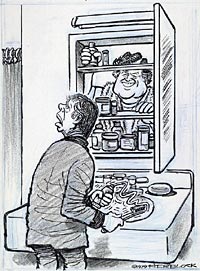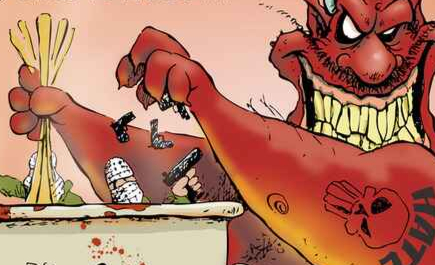Everyone’s Got An Opinion
Skip to commentsMy opinion is to stand foursquare behind Michael Cavna, who closed out 2024 with a five part Warped statement, starts here, on the dangers we face without political cartoonists and the dangers political cartoonists face from authoritarian governments.





My other opinion is that Andrews McMeel should collect this series and submit it to the Pulitzer board. It is, after all, a perfect example of the Pulitzer’s new Illustrated Reporting and Commentary category which calls for “a distinguished portfolio of editorial cartoons or other illustrated work (still, animated, or both) characterized by political insight, editorial effectiveness, or public service value.”

One of Michael’s other jobs is reporting on cartooning for The Washington Post.
During his presidency, Carter was routinely lampooned over issues such as inflation, the energy crisis and geopolitics, including the Iranian hostage crisis and mostly excluding the Camp David peace accords. Yet eventually during Carter’s long post-presidency, as his reputation as a humanitarian and a diplomat grew, the cartoons became more glowing.
“Herblock and many other editorial cartoonists characterized Carter as an honest but ineffective leader during his presidency,” said Sara Duke, curator of graphic art in the Prints and Photographs Division of the Library of Congress. “As he started to run for reelection in 1979 and 1980, many cartoonists placed in him in the shadow of Sen. Ted Kennedy.”

On the occasion of President Carter’s passing Cavna talks to Sara Duke and cartoonists Mike Luckovich, Jim Borgman, Jack Ohman, Joel Pett, and Matt Wuerker about cartooning President Carter post-Presidency for The Washington Post (behind a paywall – anyone have a gift link?).
Hey!

Alexandra Bowman has her new page up at Cagle Cartoons.
Yet another Best Cartoons of 2024 (part 6 I guess).

Hearst’s CT Insider editor John Breunig presents: Opinion: The best of 2024 political cartoons
Speaking of The Washington Post (see above cartoon) and Best Cartoons of the Year…
Mike Rhode at Comics DC notes that The Washington Post is apparently forgoing a long tradition:
The Post does not appear to be doing the traditional feature, which dates back decades. Ann Telnaes, Michael Ramirez, and Edith Pritchett appear regularly in the Post … Neither a ‘best of everyone’ or best of Telnaes appeared in print or on the website as far as I can tell.
Dirty Laundry.
The sister of famous cartoonist Michael Leunig has celebrated the death of her brother on Instagram, describing him as a sexual abuser and shameless attention seeker.
In a post which has drawn praise from her followers Mary Leunig wrote just a week after her 79-year-old brother’s death: ‘I’ve been wishing him dead for some time now.’

Candace Sutton for The Daily Mail reports the story of bad blood between the siblings and why.
Bookending Cavna’s opening cautionary tale with a factual account.
In the magazine Cartoonists India, former Reader’s Digest India editor Mohan Sivanand relates an anecdote about Shankar Pillai, one of the pioneers of cartooning in the country. In 1932, a few months after he had joined as a staff cartoonist with the Hindustan Times, Shankar got a summons from the viceroy, Lord Willingdon. Shankar met the viceroy with some trepidation, only to be welcomed with a broad smile and a pat on the back. He conveyed to the cartoonist how much he enjoyed his work. His wife, however, had one complaint. “Why do you draw my husband’s nose so long?” she asked him. Shankar explained how caricaturing entailed the exaggeration of certain features. “Now, even if I draw only that nose, people will know it is your husband,” he told Lady Willingdon. The Willingdons had a hearty laugh. Compare that with today’s India, when our leaders have lost their sense of humour so much that exaggerated noses will get them breathing down your neck.

Anjuly Mathain in The Week explains that Cartoonists are the vanguards of democracy.
Those were the halcyon days of Indian cartooning, but they were not to last. Shankar’s Weekly wound up in 1975, after Emergency was declared. “We could have taken the Emergency in stride, but the burden of running a weekly magazine on a shoestring was too much,” wrote Shankar in the last issue of the magazine. With censorship introduced during Emergency, mirth became a punishable offence, and so did Shankar’s stance that “everything that is laughable will be laughed at”.


Comments 4
Comments are closed.